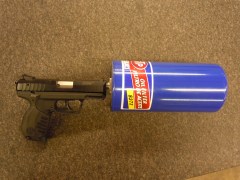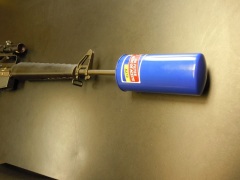As many of our readers are aware, Attorney Adam Kraut and I attended the NSSF’s Import/Export Conference on August 2-3, 2016, for which we blogged about many of the statements made by ATF (and other federal agencies) in our blog – News from the Round Table Discussions at the NSSF Import/Export Conference. One issue that we did not discuss is ATF’s statements during the Round Table Discussions relating to ATF’s position on “makers” of silencers/suppressors, especially relative to what been called “solvent traps.”
For those who are unaware, there are a number of business offering “solvent traps,” which are designed to thread on the end of one’s barrel to capture the solvent, typically in an oil or fuel filter threaded on the end.


While the use of these devices for purposes of collecting solvent is questionable, many of these companies advise their customers that if they want to be able to use the solvent trap as a silencer/suppressor, the customer must first file a Form 1 with ATF to make a silencer and receive approval, before utilizing the solvent trap for purposes of being a silencer. (While we would advise our clients to file a Form 1 and obtain approval of ATF prior to even purchasing a solvent trap or similar device, so to prevent against constructive possession charges, such is beyond the scope of this article).
Under the National Firearms Act (“NFA”), 26 U.S.C. 5801, et seq, one who wishes to “make” an NFA firearm must file an application with the Attorney General, pursuant to 26 U.S.C. 5822. (Although the statute still references the Secretary (of the Treasury), when ATF was moved under DOJ in 2003, it changed to the Attorney General). Under the NFA, pursuant to 26 U.S.C. 5845, “make” is defined as to “include manufacturing (other than by one qualified to engage in such business under this chapter [26 USCS §§ 5801 et seq.]), putting together, altering, any combination of these, or otherwise producing a firearm.” While the NFA, pursuant to 26 U.S.C. 5841, does differentiate between a “maker” and a “manufacturer” in relation to how one is to initially register an NFA firearm and does define “make” as mentioned previously, nothing in the NFA differentiates between the rights of a “maker” and those of a “manufacturer.”
Nevertheless, during a discussion on ATF-29p (ATF’s Advanced Notice of Proposed Rulemaking relating to Silencer/Suppressor engravings), ATF’s Mike Curtis and Earl Griffith with the Firearms and Ammunition Technology Division (“FATD”) stated that ATF views “makers” of silencers/suppressors differently than “manufacturers.” Specifically, the example of solvent traps was brought up, where they stated that ATF’s position is that a “maker” of a silencer cannot replace a silencer part without filing a new Form 1, paying another $200.00 and obtaining approval from ATF; whereas, a manufacturer, may lawfully replace a silencer part in a silencer it manufactured, provided that the part that is being replaced is destroyed. While there does not exist any specific statutory provision to support this contention, Mr. Curtis went on to explain that an individual who files a Form 1 to make a “solvent trap silencer” can only use the original oil/fuel filter that is installed and is barred from replacing a previously utilized oil/fuel filter with a new filter, absent a newly approved Form 1.
While Mr. Curtis did admit that to his knowledge ATF has not been asked to make a determination on a solvent trap silencer, he was explicitly clear that if a determination request was filed (or criminal charges brought against someone in such a situation), ATF would specifically find and contend that a “maker” of a silencer/suppressor may not repair/replace any part of the silencer/suppressor without first obtaining another approved Form 1.
Obviously, ATF’s position has a great impact on the Firearms Industry, as many individuals have made their own silencers/suppressors, long before the solvent trap silencers, and have been under the impression that like a manufacturer of a silencer/suppressor, they may lawfully replace a part in that silencer, provided that they destroy the part being replaced.
While Firearms Industry Consulting Group (FICG), a division of Prince Law Offices, P.C., does not agree with ATF’s position, we believe it is extremely important to advise those who have Form 1’ed their own silencer/suppressor of ATF’s position, since non-compliance could result in federal charging.
More crazy rule making. How would ATF even know if a legally home made form 1 suppressor had a baffle replaced. More legal fear mongering by ATF to scare honest people into catch 22 circumstances. I fear the days of this overreaching micromanaging government are coming to an end, much like King George’s rule came to an end in 1776.
LikeLike
This would seem to indicate that a baffle strike on a suppressor with replacable baffles would require a new form 1 and a tax in order to replace the baffle. It seems a bit odd.
LikeLike
Correct, if a non-licensee made the silencer/suppressor
LikeLike
I ordered two of these solvent traps not knowing the rules. What do I do now? Destroy them as soon as they arrive? Obtain a form 1, pay the $200 and wait for approval? I Don’t want any trouble just want to stay on the right side of the law.
LikeLike
Is it time to shoot these unelected rule makers yet?
LikeLike
When I enter the specifications of a solvent trap suppressor on Form 1, the only thing I put is the length and caliber of the suppressor. Nowhere is it recorded how many baffles, what type of baffles, or anything else. I really don’t understand how they can possibly enforce this. It’s just bizarre.
LikeLike
Josh,
I am stuck on this part:
“[W]hereas, a manufacturer, may lawfully replace a silencer part in a silencer it manufactured, provided that the part that is being replaced is destroyed.”
Several 07/02s offer services to repair or re-core silencers made by an assortment of manufacturers, not just cans made by them. Is FATD now stating that licensed manufacturers cannot do this? Or is the statement just a general explanation?
LikeLike
I did not specifically ask but I did not get the impression that they were back-tracking on their prior determination that such was lawful.
LikeLike
That brings up a question of changing ingredients in your lower receiver or any part of any firearm at that
LikeLike
This is really nothing new. We’ve known that this is the ATF’s position since 1999 thanks to a letter written to a Mr. Bardwell:
http://www.titleii.com/bardwell/atf_letter66.txt
“As you are aware, the terms “firearm silencer” and “firearm
muffler” mean any device for silencing, muffling, or diminishing
the report of a portable firearm, including any combination of
parts, designed or redesigned, and intended for use in assembling
or fabricating a firearm silencer or firearm muffler, and any part
intended only for use in such assembly or fabrication. Thus,
certain internal components, intended only for use in a silencer,
are silencers as defined.
If an individual made one of these parts, even for use as a
replacement part, the individual would be making a silencer. Under
the provisions of the National Firearms Act, any person must apply
for and receive permission to make a silencer and pay the making
tax for each silencer made. This would require the individual
owner to file an ATF Form 1 application for each silencer part to
be made with the payment of $200.00 for each application prior to
making any replacement part.”
LikeLike
The thing is, I’m not repairing it, I just wasn’t done building yet.
LikeLike
Ian V. Hogg
“Ammunition”
Suppressed Ammunition…..
contains the products of combustion.
Cast Acrylic Sabot…..
disintegrates upon leaving the barrel.
Silicone Adhesive….
Obfuscates Firing Pin strike on primer
Prefired Rounds out of a Shotgun…
Preferably from a very public Range.
The Laws of Physics will always outweigh the Laws of Man.
LikeLike
I have a feeling that replacing a part on a silencer would be extremely difficult to prove.
LikeLike
I was charged with possession of a home made silencer 44 counts! The ATF ruled I only had actually 24 and that number was very questionable. They are not Fu–ing around! I had 1 solvent trap collector for sure and they dismissed the charge as long as I plead guilty to possession of 35 high capacity (30rd.) magazines which were legal pre-ban! 18 mo. in jail is much better than 20yrs. Especially at age 63. Mass. is a 10 rd. state. If this had happened 1 mile up the street in NH there would not have been a single charge! All because I beat up a thief and he went to the cops and told them I was selling guns which was a lie.This is what happens in The Peoples Republic Of Communist Taxachusetts! AND They revoked my wife’s license for improper storage in our own home! (loaded pistol in night stand beside bed)
LikeLike
the whole authority of the NFA is taxing commerce. If you build a suppressor yourself no commercial transaction has taken place. Therefore the government has NO right to tax you or make you register it since the registration is only allowed to prove who has paid the tax. As long as you can legally own a firearm and do not sell it.
LikeLike